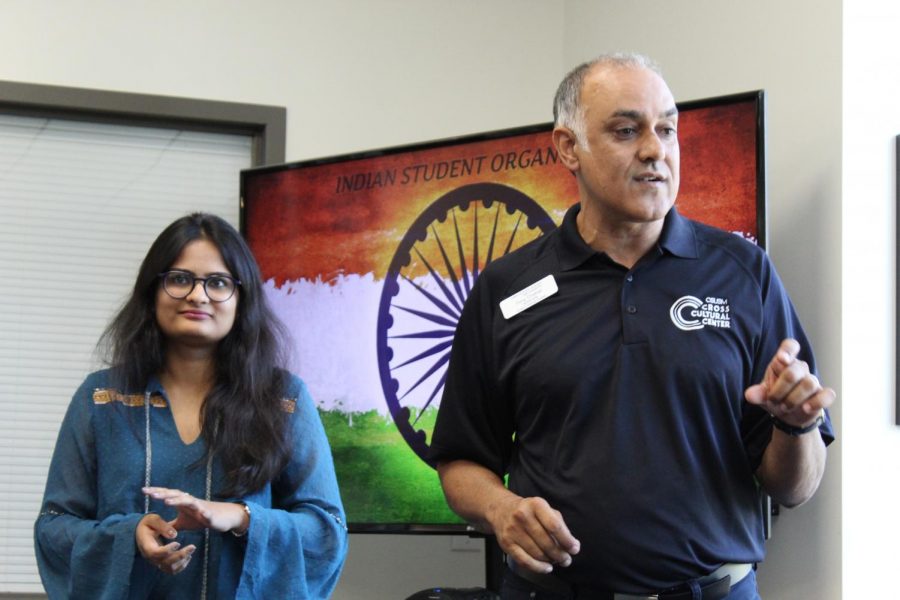Lecture series educates students on diverse culture of India
Devanshi Upadhyaya (left) and Tony Chahal (right) share various aspects of their Indian culture at the Cross-Cultural Center.
Members from the CSUSM Indian Student Organization educated students and dispelled myths about the misconceptions of Indian culture at Beyond the Taj Mahal: Desi Identities and Experiences.
The Cross-Cultural Center collaborated with the CSUSM Indian Student Organization to host Beyond the Taj Mahal, which is part of a lecture series of Asian and Pacific Islander cultures and experiences, on Sept. 19.
Before the three presenters from the CSUSM Indian Student Organization began their presentation, Tony Chahal, a program specialist at the Cross-Cultural Center, spoke to students about the purpose of hosting Beyond the Taj Mahal, saying that the Cross-Cultural Center wants to be more inclusive and combat negative stereotypes about different cultures.
Chahal said that the term Desi refers to those who identify as Indian.
Chahal said that the Cross-Cultural Center and CSUSM Indian Student Organization “want to dispel the myths [about Indian culture],” and remind others that “there is no such thing as a typical Indian.”
Devanshi Upadhyaya, President of the CSUSM Indian Student Organization, began the presentation by introducing herself and the other speakers from the same club, Natasha Bhatnagas, Vice President and Ria Shauma, Treasurer, then proceeded to show students a map of India. All three speakers discussed how each state in India has its own language and dialect, but shared many similarities.
Prior to the speakers showing the state map of India, students had filled out a questionnaire, which asked students how many official languages they thought were spoken in India. Chahal and Upadhyaya said that the correct answer was 23, but that there are over 1,000 languages all together. This questionnaire was used to show how diverse India is.
Upadhyaya, Bhatnaga and Shauma also showed a slide about saris, a type of traditional Indian clothing, and explained how they can be worn in 14 different ways, depending on the region in India. One of the examples of how saris could be worn was the Gujarati sari, which is a thick decorated cloth that is draped over the chest of the dress and worn in the state of Gujarat.
The presenters also discussed the differences of food between the states in India, as well as the festivals that are celebrated.
The Festival of Dance Navaratri, a Hindi festival that celebrates the goddess Devi, is a ten day ordeal each year. Navratri is celebrated all over India. There are different ways to dance to music at the festival. The speakers showed students a video clip of how to do a basic version of the complicated dance and played a snippet of a song that it is danced to.
One big similarity that the presenters said that many Indians shared were for the appreciation of the Golden Temple, a sacred and religious Sikh temple made of gold back in 1577. They said that the temple feeds 1one million people every day and that everyone who enters the temple becomes equal and leaves the caste system behind after washing their feet.
After the presentation ended, the speakers took questions that students had about Indian culture and stereotypes.
Upadhyaya said the purpose of the lecture was to “let people know about and be aware of the India that lies beyond the Taj Mahal… there’s more to it, there’s this beautiful traditions,… several religions and cultures.”
“We really hoped that they [students] learned anything new about India that they never knew about, to clear some of the myths that have been going around… we wanted to make sure that the facts came out… and to know the true India,” said Upadhyaya.
Afterwards, students then had a chance to socialize, talk with the speakers and continue eating the vegetarian samosas and other vegetarian Indian food catered at the event.
Sammit Kulkarmi, a computer science major who attended the lecture, said that the most impactful information that he took away was “how diverse India is and how many different languages are spoken in India.”
Kulkarmi said that he hoped that other students at the lecture learned that “India is much more than just a very populated country, it is very diverse, as it has a very deep culture.”
The next installment of the Asian and Pacific Islander cultures and experiences series is The Latinos of Asia: An Evening with Dr. Anthony Ocampo at the USU Ballroom on Oct. 10 from 6 p.m. to 7:30 p.m.


